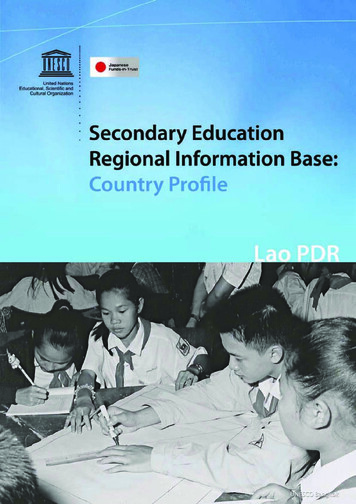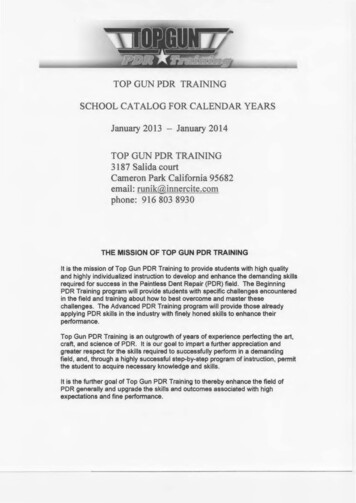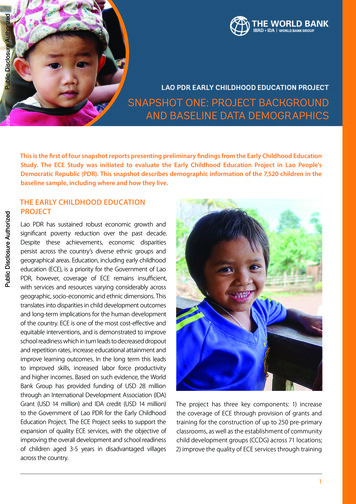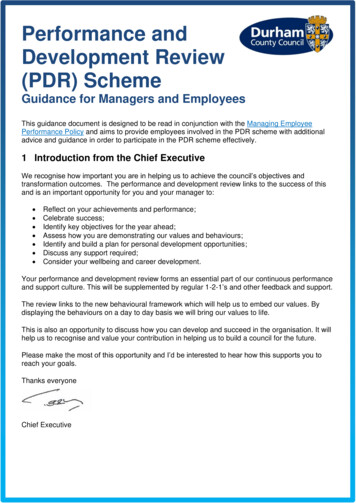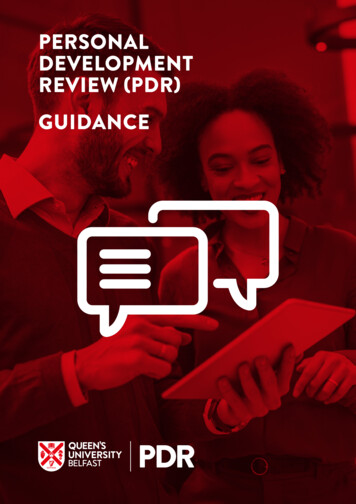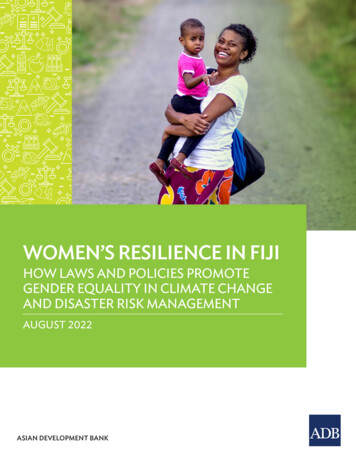
Transcription
Lao People's Democratic Republic Country OverviewThis Country Overview document was prepared by Government of Lao PDR ahead of the SWA 2020Virtual Regional Finance Ministers’ Meeting. This is a snapshot of the country’s current state in termsof water, sanitation and hygiene, and future targets.1. Country ContextThe geography and demography of the Lao People’sDemocratic Republic (Lao PDR) plays an important role inits development. With a population of 7 million in 20171, LaoPDR is predominantly a rural country with 67% of population living in rural areas. In addition, 70% of the country’s areais mountainous, with many remote and inaccessiblecommunities. The country also faces frequent exposure to extreme weather events and disasters such as floods and typhoons, which makes it more vulnerable to climate relatedfiscal shocks and impacts the safety of its water andsanitation infrastructure. The impact of flood related events generates large costs for government, businesses,households, with estimated losses for Lao PDR ranging from 2.8% to 3.6% of GDP2.LAO PDR COUNTRYCONTEXT3-tier administrative system; 18 provinces,sub-divided into148 districts and 8,421villages67% of the population live in rural areas.Only 2 in 7 of the poorest households use abasic sanitation facility, leaving them evenmore vulnerable to climate related challengesSanitation coverage in rich households (99%)is four times that of the poor (23%).Estimated losses due to climate and floodrelated disasters range from 2.8-3.6% ofGDP.2Lao PDR, like many other countries across the globe isSource: Lao Statistics Bureau (LSB), 2019;Lao Social Indicator Survey, 2017going through a challenging time with the onset ofCOVID-19 in 2020 responding to the health and crosssectoral socio-economic issues that the pandemic haspresented. While the number of confirmed COVID-19cases has been low compared with neighboring countries, the impact of the pandemic goes significantlybeyond the numbers of cases, with the full extent of the socio-economic impact still evolving.The 9th National Socio-Economic Development Plan of Lao PDR (NSEDP)3 outlines the country’sdirection until 2025 and emphasizes on economic restructuring to attain a higher level of quality, greenand sustainable growth. It also lays a strong foundation to graduate from the Least Developed Country1 Lao Statistics Bureau, 2017. The last census produced a population of 6.492 million (Lao Statistics Bureau, 2015).2 Based on analysis using historical loss data from the Emergency Events Database (EM-DAT). World Bank, AdvancingDisaster Risk Financing and Insurance in ASEAN Member States: Framework and Options for Implementation, vol. 1, mainreport (Washington, DC: WB).3 9th National Socio-Economic Development Plan of Lao PDR (Draft)1
status and realize Sustainable Development Goals by 2030. With the 9th NSEDP, Lao PDR has set atarget of safe water utilization rate to reach 95% and household level toilet utilization rate to reach 85%by 2025. It also aims to implement more inclusive and better-quality healthcare services with a primaryfocus on hygiene, disease prevention, and health promotion. To achieve these targets, Lao PDR willrequire financing estimated USD 247 million in cash and kind up to 2030, an estimated USD 92 millionfor the next two years to remain on track to reasonable SDG achievement, or USD 46 million annually,to develop sanitation and manage water services and resources for the future.4 An improved sanitationand hygiene status is critical to the intent of the Government to tackle the high level of malnutrition, withCU5 stunting still at 33% in 2017 (LSIS 2017).Access AreasProgress till Date(as per 8th NSEDP)Target till 2025(as per 9th NSEDP)Basic Sanitation75% (2019)85%Basic Water85% (2019)95%The overall economic costs of poor sanitation in Lao PDR were last estimated to be US 193 million peryear, which is equivalent to about 5.6% of the GDP5. While household financing accounted for morethan half of total expenditure on domestic sanitation, the cost of building an improved latrine remainshigh, making it unaffordable for most low-income households. Poor sanitation and hygiene cause atleast 3 million disease episodes and 6,000 premature deaths annually in Lao PDR6. Furthermore,nationwide deprivation overlap between Nutrition, Water and Sanitation is among the highest forchildren aged 0-17 in Lao PDR7. Hence, a single dollar invested in WASH can give manifold returns inhealth and nutrition sector.In accordance with the national planning process and continued SWA engagement, interventions in fivekey areas are required to be continued for a sustained sector progress:1. Resource mobilization and allocation: Channel adequate public and private investment for ruralsanitation and hygiene, and water supply, and mainstream climate change and DRR strategiesinto development programs2. Scale-up strategies in Social Behavior Change Communication (SBCC) and sanitationmarketing to eliminate open defecation in rural areas and improve access to basic sanitationlevel.3. Strengthen coordination within government and multi-sectoral coordination with partners atnational and sub-national level, while improving sector wide capacity for better WASH servicedelivery.4. Identify and better target resources to improve WASH coverage for the poorest and vulnerablegroups, schools and health facilities through collaboration and convergence with partners’programmes.5. Increase regulatory oversight and monitoring of KPIs in water supply and improve quality inorder to achieve and sustain the new standards for safely managed services while enablingutilities to become attractive for additional financing.4 National Strategy for Rural Water Supply, Sanitation and Hygiene for Lao PDR 2019-20305 Hutton et al. (2009) Economics of Sanitation Initiative: The Economic Cost of Poor Sanitation in Lao PDR. World Bank.Available here6 Findings from Hygiene and Sanitation Financing Study in Lao PDR. World Bank 2012. Available here.7 Provincial Profile on Child Wellbeing in Lao PDR. UNICEF 2019.2
In addition, establishing a fit for purpose monitoring system which provides suitable information for datainformed decision making and disaggregation of associated SDG criteria is needed to better assessgaps, inequities, priorities and progress as the country moves forward with the 9th NSEDP targets.2. WASH Sector OverviewDespite the ongoing challenges in 2020, the country made progressive strides in sanitation by declaringBorikhamxay the first open defecation free province. Lao PDR has also continued to make progress incoverage of basic drinking water services and basic sanitation and hygiene services, but challengesremain.The proportion of households accessing a basic water supply has increased from 69% in 2011 to 78%in 2017. However, disparities and water quality issues persist, with 6 out of every 7 households drinkingwater contaminated with faeces and the poorest households seeing almost no progress in access tobasic water supplies from 2011 (56%) to 2017 (57%). In terms of sanitation, 7 in 10 households nowhave access to a basic sanitation facility (coverage increased from 57% in 2012 to 71% in 2017)8. Theprevalence of open defecation also fell from 38% in 2011/12 to 24% in 2017. Progress is roughly ontrack to achieve universal coverage by 2030 in all schools, with about 4 in 5 schools having water (78%)and sanitation (80%) facilities. In addition, 72% women and girls in Lao PDR have appropriate menstrualmaterials and a private place to change with water. However, concerns remain with only 29% of womenand girls in poorest households having access to materials and changing facilities.9 in 10 households in Lao PDR have a handwashing facility, but with only 1 in 2 households using soap,the benefits of high handwashing rates are not fully realized8. Although COVID-19 presentedopportunities for strengthening of handwashing behavior and systems across the country, reliable dataon handwashing facilities and practices in healthcare facilities and schools is required to ascertain theimprovements achieved. In response to this, Lao PDR recently approved national policies, strategiesand guidelines with a strong focus on handwashing. Additionally, handwashing is a key focus of theNational Health and Education Five Year Sectoral Plan currently under development.Figure 1: Sanitation Coverage EstimatesLao PDR Sanitation LadderNational (%)Urban (%)Rural (%)200020172000201720002017At least Basic287467951764Limited Shared1343 13Unimproved928 193Open Defecation62212117331Source: Progress on household drinking water, sanitation and hygiene 2000-2017. Special focus oninequalities. New York: United Nations Children’s Fund (UNICEF) and World Health Organization(WHO), 2019.8Lao Social Indicator Survey; LSIS II 20173
Enabling Environment: The country has approved a National WASH Policy and a Rural WASHStrategy. The 2019–2030 Strategic Framework for Rural Water Supply, Sanitation and Hygiene for LaoPDR sets out the policy and planning framework up to 2030. The Strategic Framework prioritizesproviding WASH services to households, communities, schools, health centres and health-care facilitiesin the rural areas and to public facilities, such as temples and markets. The Framework emphasizesthe need for support in terms of human resources development, capacity strengthening, goodgovernance and financing, and the establishment of a dependable sector planning, monitoring andevaluation system capable of monitoring service-level status.In addition, the 2019 National Policy on Water Supply, Sanitation and Hygiene provides the principles,guidelines and roles for all actors. It sets out 16 policy statements (Box1) and clarifies institutional rolesand responsibilities. The Policy emphasizes that the capability of local stakeholders is vital in decisionmaking and implementation. It is in accordance with the Sam Sang framework of 3 Builds9, and boththe national policy and strategy are being disseminated widely across all levels.The country has also adopted and formalized a National Disaster Management Law in 2020 tostrengthen disaster preparedness and response, which will facilitate strengthened resilient WASHprogramming. Furthermore, a Climate Change and Health Adaptation Strategy (2018-2025) and ActionPlan (2018-2020) was also developed and approved by Ministry of Health, Lao PDR to supportconvergence between cross-cutting issues related to WASH, Health and Climate Change. WaterQuality Standards; 2014, Basic Environmental Health Standards in HCFs; 2018 and Health Care WasteManagement Regulation; 2017 were also developed to support the regulatory framework in the country.Building Back Better: Lao Government is demonstrating commitment by ensuring that the NationalCommunication Taskforce provides key hygiene messages related to COVID into all villages throughmass media campaigns. Funding is also being channeled into providing handwashing facilities inschools and providing soap for all school children with the support of GPE10 program. Lao PDR hasrecognized that COVID presents opportunities as well as a threat. Government has issued a nationaldirective on handwashing as part of the new normal. This is being complemented by the introduction ofWASHFIT programming in Health Care Facilities with support of WHO. Furthermore, handwashingindicators are also being included in national health and education monitoring to better assess nationalprogress.Scaling ODF provinces in Lao PDR: Post the success achieved with Borikhamxay Province,heightened support is being provided to other provinces to replicate the District Wide Approach forattaining open defecation free provinces. Provincial departments are being supported throughknowledge exchange visits to Borikhamxay and learn more from their experience and success.Furthermore, Vice Governors from the 18 provinces in Lao PDR have signed commitments to ensurethat each province will reduce by at least one-third the percentage of children who aremultidimensionally deprived by 2030. This will require prioritized and sustained investments to help Laochildren achieve their full potential by 2030.9The government decentralization policy through the 3 Builds policy of: strengthening provinces, supporting districts andmaking villages as development units.10Global Partnership for Education; COVID-19 Accelerated Funding4
3. Socio Economic Impact of COVID on SDG 6 ProgressCOVID-19 will have an unprecedented impact on the SDG progress made so far. Although Lao PDRhas managed the pandemic well, the indirect impact of the slowing global and regional economies willalso be felt on WASH sector in the country. The World Bank simulations show that under the morefavorable scenario, the economy will contract by 1 percent and under the downside scenario by 1.8percent in 2020. In either case, 2020 will see the slowest growth rate since 1990. With the resourcesbeing diverted for addressing the immediate impact of the pandemic, the resource envelope for theSDGs and for funding the 9th NSEDP, under formulation, are likely to be impacted as well. Impactassessments by UN organizations and independent bodies are emerging and a consolidated view onthe impact is being taken up by a Multi-Stakeholder Taskforce.4. Sector Financing and Economic OpportunitiesWASH sector in Lao PDR remains highly dependent on external financial sources for investment. Mostof the external funding, mainly loans, are provided to urban water supply creating concerns for longterm planning and human resource development requirements for the sector. Public spending for ruralWASH has improved in the last few years. However, a dedicated budget line for WASH is required inthe national budget. The UN-Water Global Analysis and Assessment of Sanitation and Drinking Water(GLAAS) 2019 report provided an updated estimate of the required annual funding to reach Lao PDR’snational targets (100 per cent coverage by basic services) as US 185 million11. The financing for thesector is expected to come mainly from households, in addition to government, external supportagencies and repayable financing.Sector Potential: Adequate, reliable and equitable financing needs to be secured for both urban andrural water supply, sanitation, and hygiene. For urban services, tariff reform needs to be coupled withmechanisms to protect the poor. Improved financial policies including adequate cost recovery plans,public resource allocation, budgeting for WASH across sectors and leveraging of development financecan further support SMART investment options for WASH sector in Lao PDR. By leveraging sources ofadditional finance allocated through GCF and GEF12, opportunities to scale climate resilient WASHinfrastructure also exist, since WASH services in the country remain consistently vulnerable andexposed to natural disasters. Given the fiscal constraints likely to be evident following COVID-19, thereis also an even greater need for focus on cost-effective mechanisms. Government investments mayfocus on public benefits such as sanitation technology options, behavior change programming,strengthening of supply chains, and support mechanisms to access financing e.g. revolving funds forpoor households or guarantee supplier schemes etc. Equitable cost-recovery mechanisms may enablegreater outcomes from urban and rural water investment. There also exists an appetite for leveragingpublic private partnerships (PPP) in the country, given that half the population in the country (48%)relies on bottled water as their source of drinking water.1311 National WASH budget in 2018 was US 1.5 million12 Global Environment Facility and Green Climate Fund13 Lao Social Indicator Survey; LSIS II 20175
5. Country priorities and commitmentsCommitment No. 1: By 2025, all Lao citizens will live in an Open Defecation Free Environment in thecountry. External support agency commitments:o UNICEF’s commitment: Support to develop Sanitation Roadmap; Support to sub-nationalsanitation planning.o WHO’s14 and World Bank’s15 commitment: Support in strengthening WASH in Health CareFacilities service delivery and monitoring.o Development Partners: Align funding and priorities, targeting resources to the most depriveddistricts.o CSO commitments: Identify and implement targeted pro-poor approaches that will improvesanitation in poorest and hardest to reach areaso Academia and Training Institutes’ (Research and Learning) commitments: Develop trainingpackage on sanitation and Hygiene Promotion and provide training to produce sanitationcadres.o Private sector commitments: Engagement with government partners and all stakeholdersto support universal access and use through private sector actors.Commitment No. 2: By 2021, a National WASH Committee is established to provide guidance on WASHpolicy implementation External support agency commitments: Technical support for N-WASHCOM Secretariatincluding dedicated capacity development activities based on a training needs assessment. Represent Private Sectors (Chamber of Commerce etc.) and contribute as memberrepresentative to National WASHCOM.Commitment No. 3: By 2022, establish a National WASH Trust Fund to finance for sustainable WASHService delivery. (External support agency commitments: Support to develop Guidelines and StandardOperating Procedure for management of National WASH Trust Fund. DP: Align funding for WASH Sector financing to achieve national target; provide budgetarysupport for trust fund (pool of fund); Develop business proposal for private sectors CSO/NFA: Mobilize communities (WASHCOM) to raise fund for operation and maintenance Academia and Training Institutes’ (Research and Learning) commitments: Research andbusiness case development for WASH Innovative Financing Private sector commitments: Develop WASH schemes under Build Operate and transfer (BOT)model14 MoH in collaboration with WHO will implement WASH FIT, combining it with a comprehensive package of interventionsfor “Safe, Clean and Climate Resilient Green” healthcare facilities (SCCRG) in 3 central, 4 provincial and 55 district hospitalsby end of 2021.15 MoH in collaboration with WB will expand the Safe, Clean and Climate Resilient Green HCF initiative in 34 HealthCenters by end of 2022.6
Box1: The 16 Principles of the 2019 National Policy on Water Supply, Sanitation and Hygiene1. Promote and protect the right of all people living in Lao PDR to access safe and sufficient waterservices, both for use and consumption equally at affordable and fair tariffs, and to safe sanitationand hygiene facilities, meeting defined standards.2. Protect water resources from all kinds of contamination which have negative impacts on waterresources.3. Support decentralization for local planning using bottom up approach. Increase implementation atlocal levels to achieve tangible results as per “3 Builds”.4. Identify priority targets, focusing on locations and sectors as follows:a. Rural settings: those who live on mountains, rural remote areas, poor and ethnic groups, andthose affected by development projects and natural disasters;b. Urban settings: those who live in suburbs (countryside) and earn minimum wages and thosewho resettle from mountainous areas to the lowlands, including poor communities in denselypopulated areas;c. Health: ensure health care facilities have safe and sufficient water supply and sanitationfacilities, and have appropriate measures for garbage and wastewater management; andd. Education and sports: ensure all educational institutions have sufficient water and sanitationfacilities. Special attention is paid to early childhood education and primary schools in rural areas.5. Build capacity for development and overall management of water supply, sanitation and hygieneservices through scheduling regular training at all levels and institutions, including for the privatesector, with particular focus on increasing women’s involvement in the water supply, sanitationand hygiene sectors.6. Ensure water for both use and consumption is fully managed, mobilized and sustainable withcommunity ownership and engagement of civil societies.7. Raise awareness on hygiene and sanitation with focus on behaviour change. Coordinate withrelevant sectors and local authorities to increase community ownership and engagement of civilsocieties in these areas.8. Implement water safety plans and focus on water quality surveillance to ensure MoH waterstandards are met, including establishment of water-quality laboratories.9. Regulate and collect tariffs of drinking water and water supply to ensure consumers receive fairtariffs and reasonable prices. This includes wastewater service charges.10. Establish effective and sustained mechanisms for monitoring and evaluation by involving relevantsectors in the monitoring of WASH sector implementation.11. Promote the use of water for production if water is sufficient in terms of quality and quantity.12. Manage the disposal of faecal sludge from septic tanks and safe disposal of related wasteproducts.13. Manage and control all pollutants which affect rivers, streams, lakes, ponds, groundwater, andother sources.14. Promote use of renewable energy and reuse of resources as much as possible.15. Enhance water security and climate change resilience with the aim to sustainably protect waterresources; prevent environmental accumulations, droughts; promote clean environments; preventpollutants and adverse effect to humans, flora and fauna, and water resources. Ensure sufficientwater is provided both in quality and quantity.16. Provide sufficient budgets to implement policies, strategies and the five-year programme of eachrelated sector, with contribution and the engagement of Government, international partners,private sector, and communities.7
One Page Snapshot/ Ministerial BriefingProgress Despite the ongoing challenges in 2020, the country made progressive strides in sanitation byachieving the first open defecation free province in BorikhamxayThe proportion of households accessing a basic water supply has increased from 69% in 2012 to78% in 2017.7 in 10 households now have access to a basic sanitation facility (coverage increased from 57% in2012 to 71% in 2017); open defecation also fell from 38% in 2011/12 to 24% in 2017.Progress is roughly on track to achieve universal coverage by 2030 in all schools, with about 4 in 5schools having water (78%) and sanitation facilities (80%).The country has approved a National Policy on Water Supply, Sanitation and Hygiene, 2019 and aStrategic Framework for Rural Water Supply, Sanitation and Hygiene, 2019–2030. A ClimateChange and Health Adaptation Strategy (2018-2025) and action plan (2018-2020) was alsodeveloped and approved. National Disaster Management Law was also adopted in 2020.Challenges The country faces frequent exposure to extreme weather events and disasters, which makes it morevulnerable to climate related fiscal shocks and impacts the safety of WASH infrastructure; Estimatedlosses from flood related events for Lao PDR ranging from 2.8% to 3.6% of GDPOnly 2 in 7 of the poorest households use a basic sanitation facility, leaving them even morevulnerable to climate related challenges; Sanitation coverage is four times better among the rich.6 out of every 7 households drinking water contaminated with faeces and the poorest quintilehouseholds still lacking access; 9 in 10 households have a handwashing facility, but only 1 in 2 usesoap, thus the benefits of high handwashing rates are not fully realized.Overall economic costs of poor sanitation in Lao PDR estimated to be US 193 million per year;Equivalent to about 5.6% of the GDP; Cost of building an improved latrine remains high, making itunaffordable for most low-income householdsNeed for a fit for purpose monitoring system which provides suitable information for data informeddecision making and disaggregated SDG criteria.Although Lao PDR has managed the pandemic well, the indirect impact of the slowing global andregional economies will also be felt on WASH sector in the country.Potential Poor sanitation and hygiene cause at least 3 million disease episodes and 6,000 premature deathsannually in Lao PDR. Children aged 0-17 also face overlapping deprivations between Nutrition andWASH. Hence, a single dollar invested in WASH can give manifold returns in health and nutritionsector.Improved financial policies including adequate cost recovery plans, public resource allocation,budgeting for WASH across sectors and leveraging of development finance can further supportSMART investment options for WASH sector in Lao PDR.Opportunities to scale climate resilient WASH infrastructure also exist by leveraging sources ofadditional finance through Green Climate Fund and Global Environment Facility,Government investments may focus on cost-effective public benefits such as sanitation technologyoptions, behavior change programmes, equitable cost-recovery mechanisms, strengthening ofsupply chains, and support mechanisms to access financing e.g. revolving funds for poorhouseholds or guarantee supplier schemes etc.Potential for leveraging public private partnerships (PPP) in the country also exist, given that halfthe population in the country (48%) relies on bottled water as their drinking water source.8
Lao PDR Sanitation Ladder National (%) Urban (%) Rural (%) 2000 2017 2000 2017 2000 2017 At least Basic 28 74 67 95 17 64 Limited Shared . schools and providing soap for all school children with the support of GPE10 program. Lao PDR has recognized that COVID presents opportunities as well as a threat. Government has issued a national
